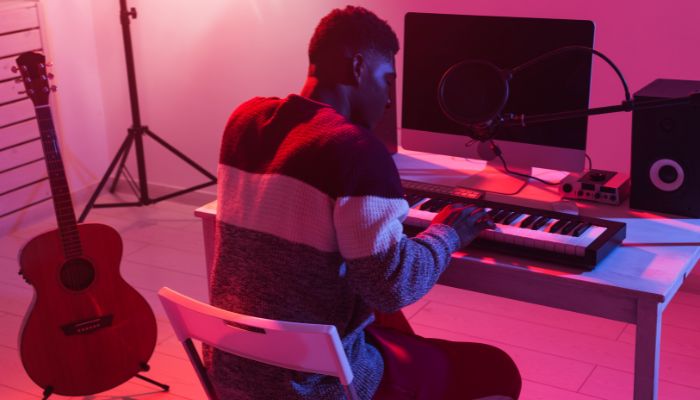Music production accessories – where do we start?!
The music production universe is home to a constellation of accessories spanning everything from monitor speakers and interfaces to MIDI controllers, plugins, headphones, and synths.
It can be pretty overwhelming to choose what you do and don’t need.
There are so many options, both hardware, and software, and it does depend on what you want to personally achieve on your music production journey.
That said, there are some accessories that all student music producers can benefit from.
Here goes!
1. Audio Interfaces
An audio interface is an essential audio and music production accessory for anyone that wants to record live sources.
They’re also essential for connecting monitor speakers to a digital audio workstation – DAW – or your PC or laptop’s internal sound card.
Audio interfaces vary primarily on how many inputs they offer.
The Focusrite Scarlett Solo offers just one XLR input and a ¼” jack input. This is an excellent music production accessory for anyone that wants to connect monitor speakers to their PC and add live audio to their productions.
Multi-input interfaces include anything from 2 to 8 mic inputs. The Focusrite Scarlett 18i20, for example, has 8 mic inputs, ideal for recording an entire drum set or small band.
Choosing an audio interface depends on what you intend to record. For solo recordists, a simple single input interface will suffice but if you envision yourself recording a full band then you’ll need to look at 8 input interfaces at least.
Recommended
Focusrite is probably the leading manufacturer of audio interfaces right now, the Focusrite Solo is the most popular single-mic input interface around.
M-Audio has also produced many much-loved interfaces in its time. Tascam is a go-to manufacturer for budget interfaces – the Tascam US1800 is the cheapest 8-mic input interface going.
2. Monitor Speakers
Monitor speakers are a must-have accessory, partnering with audio interfaces to bring your rig alive!
Monitor speakers are active speakers, meaning they don’t need to be externally amplified.
Plug ‘em into your interface and mains power and you’re good to go!
Monitor speakers are specifically designed for audio production and DJ mixing. They produce a realistic, balanced stereo image that lets you monitor your music without bias.
Recommended
There are tons of monitor speakers to choose from but you can’t go wrong with KRK Rokits or PreSonus Eris E5s. Both are superb, cost-effective monitor speakers. It’s tough to beat a pair of KRK Rokits.
They come in multiple sizes ranging from 5” to 10” and deliver superb studio-quality audio for all flavours of studio and music production
For something a little more high-end, check out the Yamaha HS series.
3. USB Microphones
USB microphones are the fastest way to record audio on your PC or laptop. They’re perfect for solo recordists, podcasters, YouTubers, voice artists, or just for general-purpose live audio use.
You don’t need an audio interface with a microphone preamp if you have a USB microphone.
They have just one wire, and plug into any USB port – super easy!
Recommended
There are many awesome USB microphones around but few can touch the Rode NT-USB Microphone which provides a balanced blend of quality and value.
Anything by USB mic brand Blue Yeti is worth a look too.
4. Stands, Cables, and Cable Tidies
Every music producer needs an array of stands, cables, and cable tidies!
Stands include keyboard and guitar stands, as well as microphone, stands. It’s good to own a couple of different-sized mic stands for varying uses, e.g. a tall boom stand for standing vocals and a short stand for guitar amplifiers.
Common cables include the humble RCA, XLR, guitar cable (TS), and TRS ¼” jack cable.
It’s also wise to grab various cable adapters, e.g. ¼” headphone jack to 3.5mm jack adapters, XLR to TRS adaptors, and TRS to XLR adaptors. Too many are always better than too few when it comes to audio cables!
And then, you’ll need cable tidies. Cable tidies keep everything neat and organized – you can use them for everything from USB cables to headphone cables and power cables. Proper studio management will keep you focused and sane! It will also protect your equipment from getting tangled up and knocked over!
Recommended
Audio cables are generally cheap and plentiful. Popular brands include Van Damme and Neutrik. Get a few different colours if you can – it makes it much easier to differentiate between different instruments, etc.
5. USB MIDI Controller
For inputting MIDI data into audio recording software, you’ll need a USB MIDI controller. These allow you to control software instruments within your software. They’re simple devices and usually inexpensive – simply hook them up to your PC or laptop via USB and you’ll be able to trigger and control sounds from within your DAW.
MIDI controllers are usually divided into pad-based controllers, ideal for beat-making and drum programming, and keyboard-based controllers, ideal for melodic instrumentation. Many are a combination of the two, featuring both a keyboard and touch-pads.
Recommended
Some popular MIDI controllers include the Native Instruments Maschine, Novation Launchpad, Akai MPK series, and M-Audio Oxygen series. You can find mini 25 to 37-key controllers as well as larger 61-key controllers.
6. Software
Software is integral to the music production process – you can’t really call it an accessory anymore.
Choosing the best production software for making music is one of the most important things you’ll do in your music production journey. There are many options; Ableton, Pro Tools, Logic, Studio One, Tracktion Waveform, Fruity Loops, and Reaper but to name a few!
Recommended
It’s difficult to recommend a DAW for everyone but Pro Tools First is tough to beat for an entry-level DAW. It lets you record/edit up to 12 tracks for free and comes with some excellent free plugins from Pro Tools’ AIR range, as well as Xpand2!, a multi-purpose software instrument.
Once you’ve got a DAW up and running, it’s time to grab some plugins!
7. Plugins
Plugins are software which ‘plug in’ to your DAW.
There are many different types of plugins. Audio processing plugins help you edit and mix your audio, they include compressors, EQ, de-essers, saturation, distortion, gates, and limiters.
Most DAWs come with a selection of decent-quality compressors, EQs, limiters, and other audio processing units. These are easily expandable with after-market plugins from software authors like Waves, Native Instruments, FabFilter, Izotope, SoundToys, and Baby Audio.
Software instrument plugins are built for sound design. They include software synths, drum kits and other audio generators. Some notable examples include Native Instruments Massive and Xfer Serum.
Recommended
The Waves Gold Bundle is a go-to for budding audio producers. It’s an awesome package of many of Waves’ most-loved plugins.
You’ll find a bit of everything in there – there are over 40 plugins in total spanning everything from compression to EQ, reverbs, and creative FX processing.
8. Headphones
Whilst you should avoid mixing on headphones, you’ll still need them to monitor live instruments and check aspects of your mix. Headphones can be used to mix your productions if you use virtual mixing software like Waves NX.
For studio use, over-ear headphones are probably the best shout. They generally offer excellent sound isolation and are comfortable to wear for long periods of time.
In-ears are sometimes preferable for musicians that need to move around, e.g. drummers.
Recommended
There are many superb pairs of monitor headphones available on the market from top brands like Sennheiser, Shure, Audio-Technica, and Beyerdynamic. A pair of Audio-Technica ATH-M50Xs are particularly good and reasonably priced. Shure SE215s are a go-to for in-ear monitoring.



